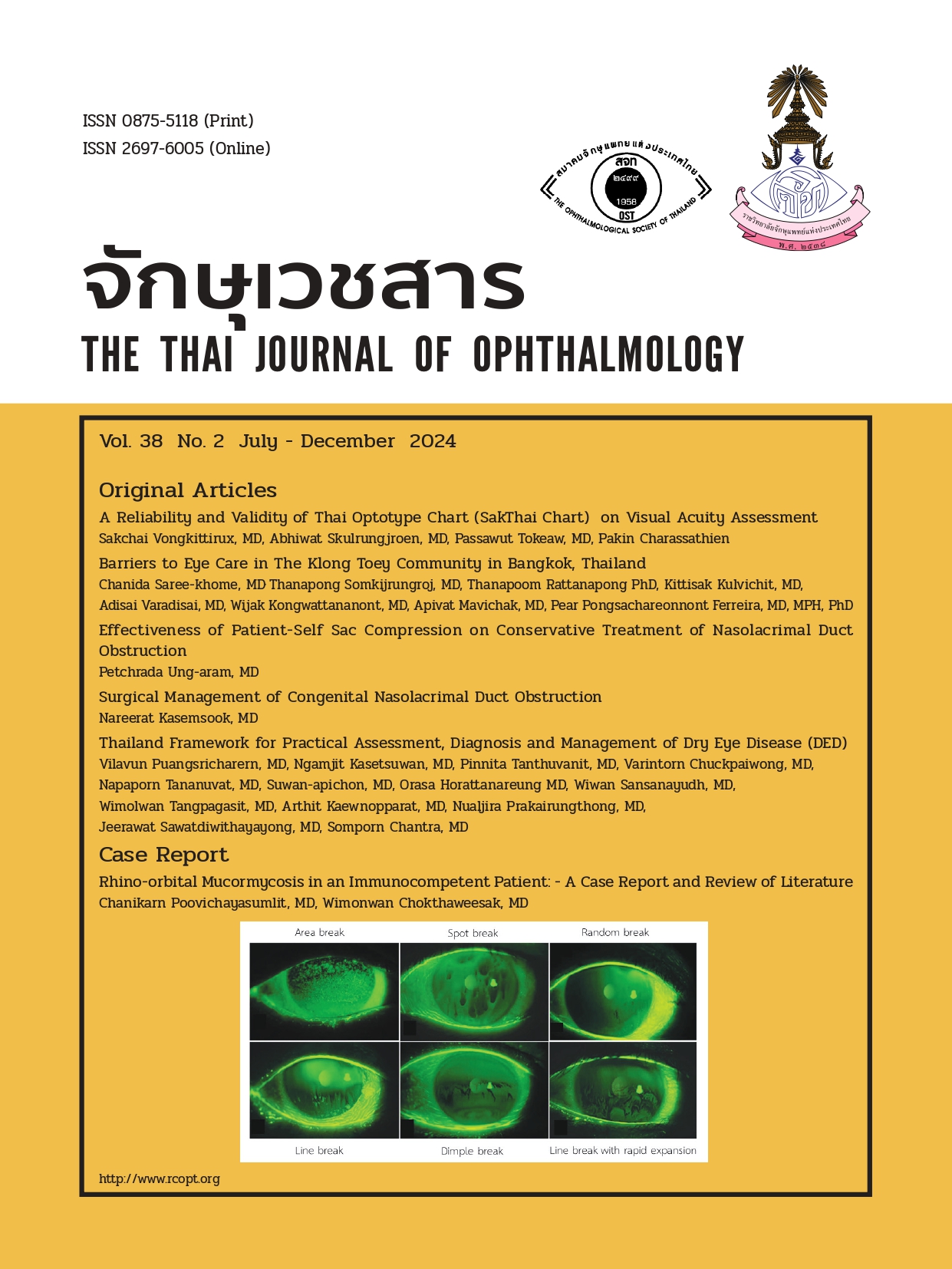ปัญหาและอุปสรรคในการเข้าถึงสถานพยาบาลเพื่อใช้บริการสุขภาพทางตาในชุมชนคลองเตย กรุงเทพมหานคร ประเทศไทย
บทคัดย่อ
ที่มาและความสำคัญ: ภาวะความบกพร่องทางสายตาและตาบอด เป็นปัญหาด้านสาธารณสุขที่สำคัญทั่วโลก โดยมีความชุกมากกว่าอย่างมีนัยสำคัญในประเทศที่มีรายได้ต่ำถึงปานกลาง การเข้าถึงการดูแลสุขภาพตานั้นมีข้อจำกัดในกลุ่มคนที่มีเศรษฐานะสังคมต่ำที่อาศัยอยู่ในชุมชนแออัดเขตเมือง แม้ประเทศไทยจะมีระบบหลักประกันการรักษาสุขภาพถ้วนหน้า ที่เอื้อประโยชน์ในการรักษาพยาบาลโดยไม่เสียค่าใช้จ่ายก็ตาม
วัตถุประสงค์: เพื่อศึกษาปัจจัยที่เกี่ยวข้องกับอุปสรรคในการเข้าถึงสถานพยาบาลเพื่อใช้บริการสุขภาพทางตาของผู้ที่อยู่อาศัยในชุมชนคลองเตย กรุงเทพมหานคร ประเทศไทย
ระเบียบและวิธีการวิจัย: ผู้เข้าวิจัยได้รับการสัมภาษณ์และเข้ารับการตรวจคัดกรองสุขภาพตา โดยแบบสอบถามประกอบไปด้วยส่วนของข้อมูลทางประชากร ภูมิหลังทางเศรษฐกิจและสังคม ประเภทของสิทธิการรักษา ปัญหาทางสุขภาพตาที่มี รวมถึงข้อมูลการเข้าถึงสถานพยาบาลเพื่อใช้บริการสุขภาพทางตา และแบบสอบถาม Thai WHOQOL-BREF, ใช้การวิเคราะห์ทางสถิติแบบถดถอยโลจิสติกพหุคูณ ในการหาความสัมพันธ์ของข้อมูล
ผลการศึกษา: มีผู้ตอบแบบสอบถามทั้งหมด 313 คน ประกอบด้วยเพศหญิง 71.6% และ 28.4% เพศชาย อายุเฉลี่ย 57.67 ปี SD = 0.73 ครึ่งหนึ่งของผู้เข้าร่วมไม่สามารถเข้าถึงการดูแลสุขภาพตาได้ (50.1%) โดยมีอุปสรรคคือการมี สถานะภาพโสด (aOR = 2.05, 95%CI [1.06 – 3.95]) และ อาชีพผู้ประกอบการอิสระ (aOR = 3.24, 95%CI [ 1.12- 9.44]) อุปสรรคของการไม่ไปบริการ ณ สถานพยาบาลตามสิทธิ์ คือ การมีข้อจำกัดส่วนบุคคล (aOR = 2.64, 95% CI [1.48 – 4.73]) ผู้อาศัยในชุมชนคลองเตยส่วนใหญ่รายงานว่ามีคุณภาพชีวิตที่ดีตามมาตรฐานขององค์การอนามัยโลก (73.4%) และค่าเฉลี่ยของคะแนน WHOQOL-BREF เท่ากับ 85.82, SD = 0.63
สรุป: ครึ่งหนึ่งของผู้เข้าร่วมวิจัย มีข้อจำกัดในเข้าถึงการสถานพยาบาลเพื่อใช้บริการสุขภาพทางตา อันเนื่องมาจากการมีสถานะภาพโสดและ ผู้ที่ประกอบอาชีพผู้ประกอบการอิสระ, และอุปสรรคในการไม่ไปใช้บริการในสถานพยาบาลเพื่อใช้บริการสุขภาพทางตา ตามสิทธิ์การรักษา คือ การมีข้อจำกัดเฉพาะบุคคล
References
Pawar S. Causes of blindness and vision impairment in 2020 and trends over 30 years, and prevalence ofavoidable blindness in relation to VISION 2020: the Right to Sight: an analysis for the Global Burden of Disease Study. Lancet Glob Health 2021;9:144-60
Bourne R, Steinmetz JD, Flaxman S, et al. Trends in prevalence of blindness and distance and near vision impairment over 30 years: an analysis for the Global Burden of Disease Study. Lancet Glob Health. 2021;9(2):130-143. doi:https://doi.org/10.1016/S2214-
X(20)30425-3
Jaggernath J, Øverland L, Ramson P, et al. Poverty and Eye Health. Health. 2014;06(14):1849-1860. doi:https://doi.org/10.4236/health.2014.614217
Naidoo K. Poverty and blindness in Africa. Clinical and Experimental Optometry. 2007;90(6):415-421. doi:https://doi.org/10.1111/j.1444-0938.2007.00197.x
Khanna R, Raman U, Rao GN. Blindness and poverty in India: the way forward. Clinical and Experimental Optometry. 2007;90(6):406-414. doi:https://doi.org/10.1111/j.1444-0938.2007.00199.x
Sungkawan D, Thepparp R, Poor people's issues in slum communities: Process of learning and driving Comparing Thailand with Korea. Thai Jour of East Asia Stud. 2010;15(1):39-56.
Dandona R, Dandona L. Review of findings of the Andhra Pradesh Eye Disease Study: policy implications for eye-care services. PubMed. 2001;49(4):215-234.
Mahatnirunkun S, Tantipiwattanasakun W, Pumpaisan W, et al. World health organization quality of life brief-
Thai version. https://www.dmh.go.th/test/download/files/whoqol.pdf. Accessed December 8, 2024.
Ahmad K, Zwi AB, Tarantola DJM, et al. Self-Perceived Barriers to Eye Care in a Hard-to-Reach Population: The Karachi Marine Fishing Communities Eye and General Health Survey. Investigative Ophthalmology & Visual Science. 2015;56(2):1023-1032. doi:https://
doi.org/10.1167/iovs.14-16019
Waite LJ. Does Marriage Matter?. Demography. 1995;32(4):483-507. doi:https://doi.org/10.2307/2061670
Lillard LA, Waite LJ. 'Til Death Do Us Part: Marital Disruption and Mortality. American Journal of Sociology. 1995;100(5):1131-1156. doi:https://doi.org/10.1086/230634
Arno PS, Levine C, Memmott MM. The economic value of informal caregiving. Health Aff (Millwood) 1999;18:182-8.
Tangcharoensathien V, Witthayapipopsakul W, Panichkriangkrai W,et al. Health systems development in Thailand: a solid platform for successful implementation of universal health coverage. The Lancet. 2018; 391(10126):1205-23.
Rask KJ. Obstacles Predicting Lack of a Regular Provider and Delays in Seeking Care for Patients at an Urban
Public Hospital. JAMA. 1994;271(24):1931. doi:https://doi.org/10.1001/jama.1994.03510480055034
Syed ST, Gerber BS, Sharp LK. Traveling Towards Disease: Transportation Barriers to Health Care Access.
Journal of Community Health. 2019;38(5):976-993. doi:https://doi.org/10.1007/s10900-013-9681-1
Lamoureux EL, Fenwick E, Moore K, et al. Impact of the Severity of Distance and Near-Vision Impairment on Depression and Vision-Specific Quality of Life in Older People Living in Residential Care. Investigative Opthalmology & Visual Science. 2009;50(9):4103. doi:https://doi.org/10.1167/iovs.08-3294
Pukeliene V, Starkauskiene V. Quality of Life: Factors Determining its Measurement Complexity. Engineering Economics. 2011;22(2). doi:https://doi.org/10.5755/j01.ee.22.2.311
Salive ME, Guralnik J, Christen W, et al. Functional Blindness and Visual Impairment in Older Adults from Three Communities. Ophthalmology. 1992;99(12):1840-1847. doi:https://doi.org/10.1016/s0161-6420(92)31715-4
Majeed M, Williams C, Northstone K, et al. Are there inequities in the utilization of childhood eyecare services in relation to socio-economic status? Evidence from the ALSPAC cohort. British Journal of Ophthalmology. 2008;92(7):965-9.
Downloads
เผยแพร่แล้ว
ฉบับ
บท
License
Copyright (c) 2025 จักษุเวชสาร

This work is licensed under a Creative Commons Attribution-NonCommercial-NoDerivatives 4.0 International License.
The Thai Journal of Ophthalmology (TJO) is a peer-reviewed, scientific journal published biannually for the Royal College of Ophthalmologists of Thailand. The objectives of the journal is to provide up to date scientific knowledge in the field of ophthalmology, provide ophthalmologists with continuing education, promote cooperation, and sharing of opinion among readers.
The copyright of the published article belongs to the Thai Journal of Ophthalmology. However the content, ideas and the opinions in the article are from the author(s). The editorial board does not have to agree with the authors’ ideas and opinions.
The authors or readers may contact the editorial board via email at admin@rcopt.org.


